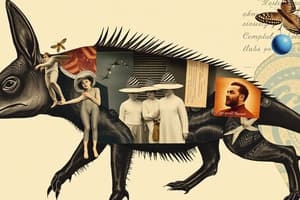Podcast
Questions and Answers
Why do animal cells lack a cell wall?
Why do animal cells lack a cell wall?
- Animal cells are more complex than plant cells and do not require a cell wall for structural support.
- Animal cells exhibit a greater degree of motility and flexibility, making a rigid cell wall impractical. (correct)
- Animal cells obtain energy through heterotrophic means, not photosynthesis, so they do not need a cell wall to protect chloroplasts.
- All of the above are true.
- None of the above are true.
Which of these is NOT a characteristic of animals?
Which of these is NOT a characteristic of animals?
- Presence of nerves and muscles
- Sexual or asexual reproduction
- Autotrophic energy generation (correct)
- Motility
- Multicellular eukaryotes
Which type of connective tissue is responsible for providing strength and elasticity?
Which type of connective tissue is responsible for providing strength and elasticity?
- Fibrous Connective Tissue (correct)
- Cartilage
- Adipose tissue
- Bone
The diversity of animal species is due to:
The diversity of animal species is due to:
Which type of muscle tissue is responsible for the movement of body parts and maintaining posture?
Which type of muscle tissue is responsible for the movement of body parts and maintaining posture?
What is a common ancestor for all of kingdom animalia?
What is a common ancestor for all of kingdom animalia?
Which type of cell junction is responsible for preventing substances from passing between cells?
Which type of cell junction is responsible for preventing substances from passing between cells?
What is the primary function of glial cells?
What is the primary function of glial cells?
Which type of neuron carries information from sensory receptors to the central nervous system (CNS)?
Which type of neuron carries information from sensory receptors to the central nervous system (CNS)?
What is the main reason animals do not have a central vacuole?
What is the main reason animals do not have a central vacuole?
What is the primary function of anchoring junctions in animal tissues?
What is the primary function of anchoring junctions in animal tissues?
What type of gland secretes substances directly into the bloodstream without a duct?
What type of gland secretes substances directly into the bloodstream without a duct?
Which of the following organ systems is responsible for the breakdown of food and the absorption of nutrients?
Which of the following organ systems is responsible for the breakdown of food and the absorption of nutrients?
Which type of cell junction is responsible for cell-cell communication, as well as ion exchange?
Which type of cell junction is responsible for cell-cell communication, as well as ion exchange?
Which of the following is NOT a type of connective tissue?
Which of the following is NOT a type of connective tissue?
Which of the following structures is responsible for receiving signals and transmitting them towards the spike initiation zone (SIZ) in a neuron?
Which of the following structures is responsible for receiving signals and transmitting them towards the spike initiation zone (SIZ) in a neuron?
Which of these correctly describes thermal acclimatization?
Which of these correctly describes thermal acclimatization?
Which of the following statements about the hypothalamus is correct?
Which of the following statements about the hypothalamus is correct?
Which of the following is NOT a mechanism used by endotherms to regulate body temperature?
Which of the following is NOT a mechanism used by endotherms to regulate body temperature?
What is the primary function of thermoregulation?
What is the primary function of thermoregulation?
What is the role of the Organ of Corti?
What is the role of the Organ of Corti?
Which of the following is an example of how an animal might adjust its physiological limits for tolerable temperatures during thermal acclimatization?
Which of the following is an example of how an animal might adjust its physiological limits for tolerable temperatures during thermal acclimatization?
Which of the following is NOT a characteristic of torpor?
Which of the following is NOT a characteristic of torpor?
Which of the following is NOT involved in the process of accommodation in the eye?
Which of the following is NOT involved in the process of accommodation in the eye?
What is the primary difference between ectotherms and endotherms?
What is the primary difference between ectotherms and endotherms?
What is the function of the oval window in the ear?
What is the function of the oval window in the ear?
What is the role of vasoconstriction in thermoregulation?
What is the role of vasoconstriction in thermoregulation?
What is the difference between rods and cones?
What is the difference between rods and cones?
Which type of sensory receptor is responsible for taste and smell?
Which type of sensory receptor is responsible for taste and smell?
Which of the following is a characteristic of sound waves?
Which of the following is a characteristic of sound waves?
How does the human ear maintain balance and orientation?
How does the human ear maintain balance and orientation?
How do hair cells in the Organ of Corti generate action potentials?
How do hair cells in the Organ of Corti generate action potentials?
What is the primary function of the skeletal system in vertebrates?
What is the primary function of the skeletal system in vertebrates?
Which type of muscle is responsible for voluntary movement?
Which type of muscle is responsible for voluntary movement?
What is the role of myosin and actin in muscle contraction?
What is the role of myosin and actin in muscle contraction?
What is the role of calcium in muscle contraction?
What is the role of calcium in muscle contraction?
What is the function of the t-tubules in muscle fibers?
What is the function of the t-tubules in muscle fibers?
What is the function of ATP in muscle contraction?
What is the function of ATP in muscle contraction?
How does the nervous system regulate skeletal muscle contraction?
How does the nervous system regulate skeletal muscle contraction?
What is the term used to describe the process of muscle activation due to stretching?
What is the term used to describe the process of muscle activation due to stretching?
What is the primary function of homeostasis?
What is the primary function of homeostasis?
Which of these is NOT a method used in homeostasis?
Which of these is NOT a method used in homeostasis?
How does a negative feedback loop work in maintaining homeostasis?
How does a negative feedback loop work in maintaining homeostasis?
Which of these is an example of a positive feedback loop?
Which of these is an example of a positive feedback loop?
What is the main difference between endotherms and ectotherms?
What is the main difference between endotherms and ectotherms?
Which of these is an example of homeothermic regulation?
Which of these is an example of homeothermic regulation?
How do heterotherms differ from homeotherms?
How do heterotherms differ from homeotherms?
Which of these is an example of a feedforward mechanism in homeostasis?
Which of these is an example of a feedforward mechanism in homeostasis?
Flashcards
Animal Definition
Animal Definition
A non-human multicellular eukaryote lacking a cell wall.
Common Ancestor of Animals
Common Ancestor of Animals
Colonial flagellated protist from the Precambrian era.
Animal Characteristics
Animal Characteristics
Includes being heterotrophic, motile, and having nerves and muscles.
Animal Tissues
Animal Tissues
Signup and view all the flashcards
Types of Cell Junctions
Types of Cell Junctions
Signup and view all the flashcards
Anchoring Junction
Anchoring Junction
Signup and view all the flashcards
Tight Junction
Tight Junction
Signup and view all the flashcards
Gap Junction
Gap Junction
Signup and view all the flashcards
Homeostasis
Homeostasis
Signup and view all the flashcards
Negative Feedback
Negative Feedback
Signup and view all the flashcards
Positive Feedback
Positive Feedback
Signup and view all the flashcards
Feedforward
Feedforward
Signup and view all the flashcards
Endotherm
Endotherm
Signup and view all the flashcards
Ectotherm
Ectotherm
Signup and view all the flashcards
Homeotherm
Homeotherm
Signup and view all the flashcards
Heterotherm
Heterotherm
Signup and view all the flashcards
Thermoregulation
Thermoregulation
Signup and view all the flashcards
Organismal performance
Organismal performance
Signup and view all the flashcards
Hypothalamus
Hypothalamus
Signup and view all the flashcards
Thermal acclimatization
Thermal acclimatization
Signup and view all the flashcards
Vasoconstriction
Vasoconstriction
Signup and view all the flashcards
Torpor
Torpor
Signup and view all the flashcards
Middle Ear Bones
Middle Ear Bones
Signup and view all the flashcards
Oval Window
Oval Window
Signup and view all the flashcards
Accommodation
Accommodation
Signup and view all the flashcards
Rods and Cones
Rods and Cones
Signup and view all the flashcards
Hair Cells
Hair Cells
Signup and view all the flashcards
Chemoreceptors
Chemoreceptors
Signup and view all the flashcards
Sound Detection
Sound Detection
Signup and view all the flashcards
Balance and Orientation
Balance and Orientation
Signup and view all the flashcards
Cartilage
Cartilage
Signup and view all the flashcards
Skeletal System
Skeletal System
Signup and view all the flashcards
Vertebrate Muscles
Vertebrate Muscles
Signup and view all the flashcards
Adipose Tissue
Adipose Tissue
Signup and view all the flashcards
Fibrous Connective Tissue
Fibrous Connective Tissue
Signup and view all the flashcards
Skeletal Muscle
Skeletal Muscle
Signup and view all the flashcards
Neuron Types
Neuron Types
Signup and view all the flashcards
Neuromuscular Junction
Neuromuscular Junction
Signup and view all the flashcards
Glial Cells
Glial Cells
Signup and view all the flashcards
Action Potential Conduction
Action Potential Conduction
Signup and view all the flashcards
Skeletal Muscle
Skeletal Muscle
Signup and view all the flashcards
Calcium Release
Calcium Release
Signup and view all the flashcards
Sliding Filament Theory
Sliding Filament Theory
Signup and view all the flashcards
Cardiac Muscle
Cardiac Muscle
Signup and view all the flashcards
Exocrine Glands
Exocrine Glands
Signup and view all the flashcards
Troponin and Tropomyosin
Troponin and Tropomyosin
Signup and view all the flashcards
Study Notes
General Concepts
- Animal = non-human animals, all members of the animal kingdom
- Animals are multicellular eukaryotes (lack cell walls)
- Animals are heterotrophs (obtain energy from consuming other organisms)
- Most animals are motile (able to move)
- Animals reproduce sexually or asexually
- Animals have nerves and muscles
Animal Characteristics
- Multicellular eukaryotes (lack cell walls)
- Heterotrophic
- Motile
- Sexual or asexual reproduction
- Nervous system
- Muscular system
Animal Diversity
- Diverse species
- Diverse habitats
- Diverse characteristics
Animal Origins
- Common ancestor for all animals = colonial flagellated protist in Precambrian
- Similarity to modern colonial flagellated species
- Morphological and molecular evidence
Animal vs Plant Cell
- Animal cells lack a cell wall and central vacuole, only vacuoles
- Plants have a cell wall and a central vacuole
- Cell wall provides tissue stability
Tissue Stability in Animals
- Animal cells do not have cell walls to provide stability like plant cells
- Animal tissues use extracellular junctions for stability
- Extracellular junctions maintain shape, structure, and function of cells
- Types of junctions:
- Anchoring junctions: attach proteins to join cells together
- Tight junctions: prevent things from passing through adjacent cells
- Gap junctions: allow cell-cell communication and ion exchange
Classifying Animals
- Animal Body Plans (e.g., bilateral symmetry, radial symmetry, body cavity types) influence their structure and development pattern.
- Animal develop based on germ layers: endoderm, mesoderm, and ectoderm
- Protostomes: The mouth is developed first; anus is formed later.
- Deuterostomes: The anus is developed first; mouth is formed later.
Sexual Reproduction
- Germ line cells undergo meiosis to form haploid gametes (sex cells).
- Gametes fuse (fertilization) to form a diploid zygote.
- Most animals undergo some form of sexual reproduction.
Asexual Reproduction
- Examples include budding in hydra, fragmentation in echinoderms, and parthenogenesis in insects
Embryonic Development Differences
- Protostomes exhibit spiral cleavage; cell fate is determined early in development
- Deuterostomes exhibit radial cleavage; cell fate is not determined early in development
Body Cavity
- A body cavity is a fluid-filled space between the gut and the body wall.
- Acoelomate animals lack a body cavity
- Pseudocoelomate animals have a fluid-filled cavity between the endoderm and mesoderm
- Coelomate animals have a fluid-filled cavity completely lined by mesoderm
Body Symmetry
- Radial symmetry can be divided equally by any longitudinal plane
- Bilateral symmetry can be divided along a vertical plane at the middle
Unifying Concepts
- Physiological processes must obey the laws of physics and chemistry
- Be tightly regulated usually (homeostasis)
Main Concept: Homeostasis
- The regulation of the body's internal environment at or near a stable level around a set point
- Important for optimal physiological performance
- Homeostatic methods include negative feedback loops, positive feedback loops, and feedforward mechanisms
Thermoregulation
- Maintaining body temperature at optimal levels to provide optimal physiological performance
- Endotherms: Obtain heat from internal reactions
- Ectotherms: Obtain heat from external environments
KEY TERMS FROM THIS LECTURE - Thermoregulation
- Organismal performance - Hypothalamus - Thermal acclimatization - Torpor - Vasoconstriction - Vasodilation
Main Concept: Animal Body Organization & Nervous System
- Organization of cells: specialized and organized into tissues
- Organization of tissues: groups of cells with the same structure and function
- Organization of organs: assembly of tissues integrated into a structure
- Organization of organ systems: group of organs that carry out related steps in a major physiological process
- Layers of organization: cells, tissues, organs, organ systems
Cell Properties in Tissue
- Acquire nutrients
- Synthesize molecules
- Sense and respond to the environment
- Protect the body
- Reproduce
Tissue Types
- Epithelial: sheetlike layers of cells, cover body surface, and lines cavities
- Connective: consists of cell networks and extracellular matrix, supports other body tissues, acts as a filter
- Muscle: long contractile cells, moves body parts and maintain posture, found in three types
- Nervous: neurons communicate information between body parts, glial cells
Connective Tissue
- Loose connective tissue: support, elasticity, diffusion
- Cartilage: support, flexibility, joint movement
- Adipose tissue: energy reserves, insulation, padding
- Fibrous Connective Tissue: strength, elasticity
- Bones: movement, support, and protection
Nervous Tissue
- Neurons: communicate information
- Glial cells: support, provide nutrients, electrical insulation
Glial Cells
- Support/provide nutrients to neurons
- Provide electrical insulation
- Scavenge foreign matter/debris
Neuron Structure
- Dendrites: receive signals, integrate, and transmit towards spike initiation zone (SIZ)
- Axons: conduct signals away from SIZ to another neuron or effector
Nervous System
- Consist of neurons and glial cells
- Nerves act as a common pathway between structures and the CNS
- CNS = ganglia and brains
Main Concept: Electrochemical Potentials in Neurons
- All cells are electrically polarized
- Have a membrane potential (MP), negative inside relative to outside
- Cell characteristics: all cells are electrically polarized, have membrane potential, negative inside relative to outside
- MP range: -10 to -90 mV
- Types of membrane potentials: resting membrane potentials (RMP), electrotonic potentials (EP), and action potentials (AP).
- Cell polarization: polarized refers to negative inside, depolarized refers to positive influx, hyperpolarized refers to increased negative inside
- Why?: needed to regulate max. cell function
Graded Potentials
- Changes in membrane potential due to changes in membrane permeability to ions.
- Part of integration; takes place in dendrites and cell bodies.
- Electrotonic Potentials: current travels along surface of membrane, can depolarize or hyperpolarize, only travels a short distance along membrane
Main Concept: Synaptic Transmissions
- Synapses: site where a neuron communicates with another neuron or effector
- Neurotransmitters: All bind to a receptor protein in post-synaptic membrane, have several different receptors, can stimulate or inhibit an effector cell.
- Receptor types: ionotropic and metabotropic
- Electrical Synapse: Gap junctions connect cytoplasm of each cell; ions flow directly between cells, rapid flow of current, excitatory only
- Chemical Synapse: Pre and postsynaptic separated by cleft; neurotransmitter stored in vesicles; neurotransmitter released; binds to receptors in postsynaptic membrane
- Release of Neurotransmitters: calcium influx, neurotransmitter release into cleft
Sensory Systems
- Environment detection
- Sensory inputs
- Sensory transduction
- Sensory receptors: Includes mechanoreceptors, photoreceptors, and chemoreceptors
- Sensory adaptation
- Perception: the conscious awareness of our external and internal environments
- Sensory Inputs
Chemoreceptors (Taste and Smell)
- Provide information about taste (gustation) and smell (olfaction)
- Work through membrane receptor proteins
- Stimulated when they bind to specific molecules
- Generate action potentials, leading to processing by the CNS
Sensory Receptors
- Respond to stimuli in their receptive fields
- Undergo a change in receptor potentials, this varies with the magnitude of the stimulus
- Change in receptor potential is caused by changes in rate of conduction of cations across plasma membrane
Nociceptors
- Detect damaging stimuli
- Located on body surface and interior
- Protective mechanisms adapt very little
Electroreceptors
- Detect electrical currents and fields
Magnetoreceptors
- Detect and use Earth's magnetic field as a source of directional information
Main Concept: Animal Locomotion; Skeleton and Muscles
- Types of animal skeletons (e.g., exoskeletons, endoskeletons, hydrostatic skeletons)
- Bone tissue
- Bone tissue (e.g., compact, spongy)
- Calcium regulation in bones
- Muscle types (e.g., skeletal, cardiac, smooth)
- Muscle structure
- Muscle physiology
- Muscle tissue types (skeletal, cardiac, smooth)
- Muscle structure (e.g., sarcomeres, myofilaments)
Studying That Suits You
Use AI to generate personalized quizzes and flashcards to suit your learning preferences.




